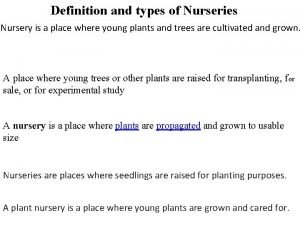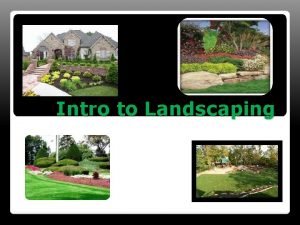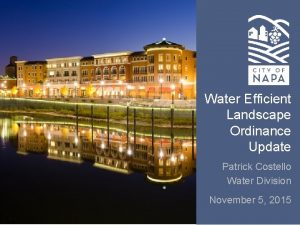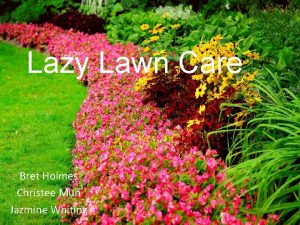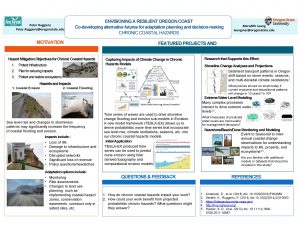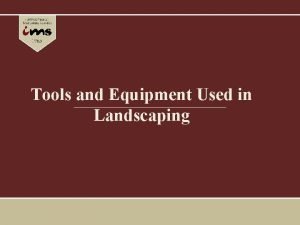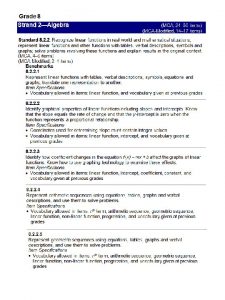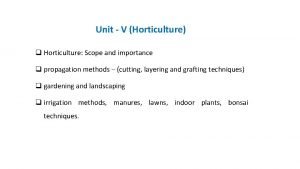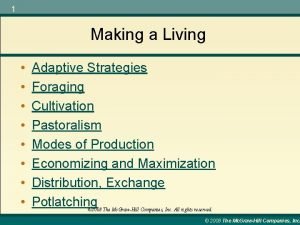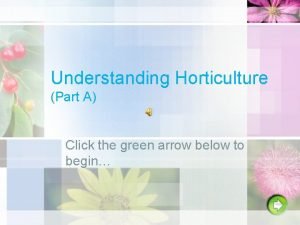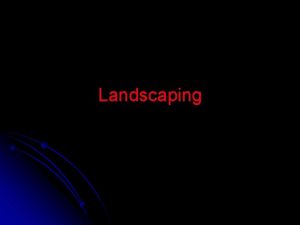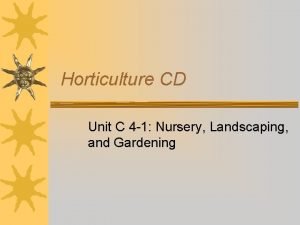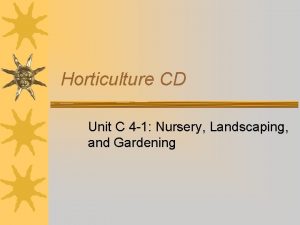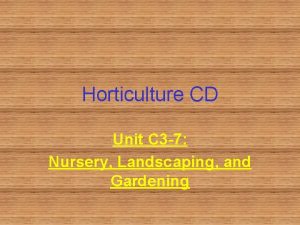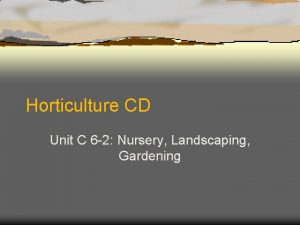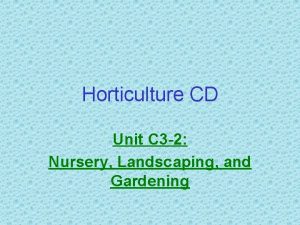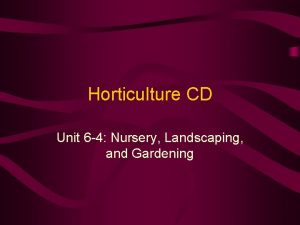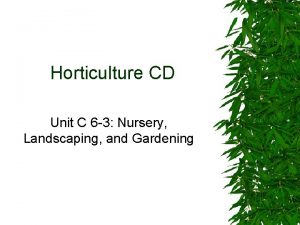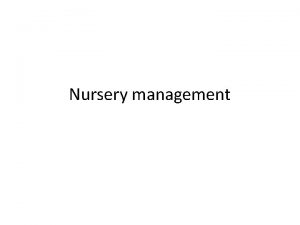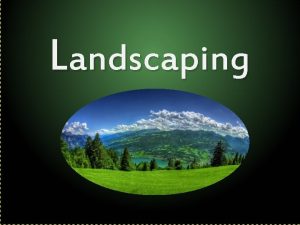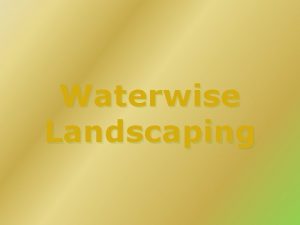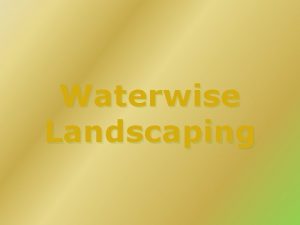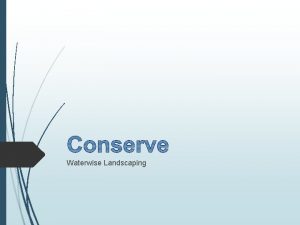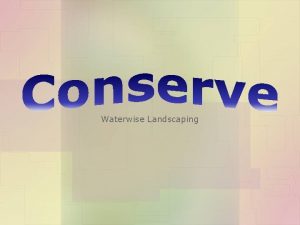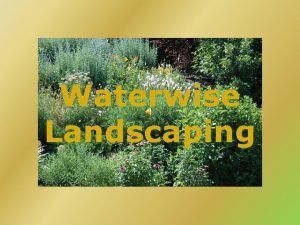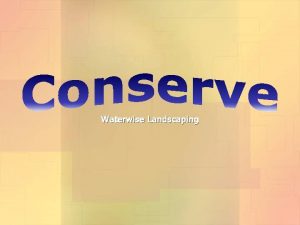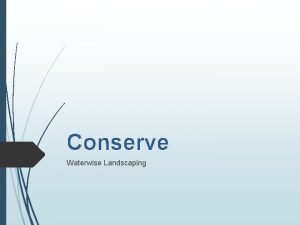Horticulture CD Unit C 3 8 Nursery Landscaping













































- Slides: 45

Horticulture CD Unit C 3 -8: Nursery, Landscaping, and Gardening

Problem Area 3. Landscape Installation

Lesson 8. Incorporating Water Features in the Landscape

Interest Approach • Is water an important feature in landscaping? • List the different water features that you have seen at zoos, parks, and in small gardens?

Student Learning Objectives • 1. Identify the different materials needed to create a water feature. • 2. Describe the proper technique for creating a small pond. • 3. Explain how to construct a waterfall feature.

Terms • Floating plants • Ground fault interrupter circuit (GFCI) • Marginal plants • Oxygenator • • Pond liner Preformed pool Recirculating pump Reglet

What are the different materials needed to create a pond? • I. Water features come in many sizes and shapes. Some are natural features of the landscape such as a stream or pond. Others are completely artificial— whether or not they try to mimic nature. – The materials needed to create a water feature are reliant upon what is trying to be accomplished and what size is desired for the feature. – A tiny formal pool will require different supplies than a large pond with a waterfall.

What are the different materials needed to create a pond? • A. Site selection will dictate many of the needs of a water feature. – 1. The water garden should receive six to eight hours of direct sunlight if flowering water plants are desired. – 2. The site should be level. It should not be in a low spot since surface drainage could run into it, creating a pollution or overflow problem. – 3. Unless the property owner is willing to put a great deal of time into cleaning maintenance, the water garden should be located away from trees that would drop leaves in autumn. – 4. The water feature should be located where it can be enjoyed from the house, patio, or other vista.

What are the different materials needed to create a pond? • B. Ponds are the most common manmade water feature. – Ponds can literally be any size or shape, although larger bodies of water are preferred for the health of the system. – Since a pond is a closed ecosystem, it is very important that each aspect of the environment be carefully maintained and balanced. – The larger the body of water, the easier this is to accomplish.

What are the different materials needed to create a pond? • 1. The water turnover or circulation rate should be once every one to two hours, less if there is a filter device in use (once every four to six hours). – Water circulation improves the oxygen content of the water, keeps water cleaner by allowing better biological filtration, and helps reduce the collection of debris on the water’s surface.

What are the different materials needed to create a pond? • 2. Floating plants should cover 60– 75 percent of the water surface to reduce problems with algae. – This is especially important if fish or other animals live in the pond. • 3. Oxygenating and marginal plants (bog plants) should number one plant for every two square feet of pond surface. – Oxygenating plants are key to growing healthy fish in the pond since fish need high levels of oxygen to thrive.

What are the different materials needed to create a pond? • 4. Fish are an attractive, and important, addition to the pond. – Not only do they add visual interest, they work to keep the mosquito population from using the pond as a base of operations. – There should be fewer than one inch of fish for every five gallons of water in the pond. – If you want 4 six inch long Koi in your pond, you will need at least 120 gallons of water (4 × 6 =24, 24× 5 =120). – Adding more fish than this puts a serious strain on the ecological balance established in the pond.

What are the different materials needed to create a pond? • 5. Snails are another important pond addition. – They help to reduce problems with algae growth since they are algae feeders. It is easy to have too many snails. – Aim to have one inch of snail for every one square foot of bottom surface in the pond.

What are the different materials needed to create a pond? • C. Ponds should be made of concrete, clay, plastic, or a flexible liner. – 1. Preformed pools are ready-made pond shells composed of fiberglass or molded polyethylene. • They come in a variety of sizes and shapes but are generally smaller since they are stiff and unwieldy. • Most shells are between 18 and 24 inches deep, making them unsuitable for overwintering fish in colder climates. • Preformed pools need a good substrate of sand or gravel since they can warp out of shape if not supported properly.

What are the different materials needed to create a pond? – 2. Pond liners are flexible, waterproof barriers that are used to line the inside of a pond. • Liners are made in a variety of materials such as PVC or EPDM (ethylene propylenediene rubber) membrane. • PVC liners are available but they are not as durable or desirable as the other options. • Some newer brands of PVC have some UV resistance and come with up to a 10 year warranty. EPDM liners are heavier and more expensive, but are much more resistant to weather and UV radiation. EPDM liners can be bought with up to a 30 year warranty.

What are the different materials needed to create a pond? – 3. Concrete, poured over a mesh grid, (called gunite) can be an extremely durable pond material. • It is however quite expensive and requires outside contracting by a business which specializes in this type of construction. • Sometimes waterproof tile or brick can also be used to create a water feature.

What are the different materials needed to create a pond? • 4. Large ponds can be cost prohibitive if created of concrete and liners not made for this use. – In order to waterproof the soil, a high quality clay is brought in. – It is graded or shaped to create a three to six inch layer at the bottom of the pond, effectively forming a waterproof basin.


What are the different materials needed to create a pond? • D. Water circulation is vital to pond health. – This can be created by using a fountain or waterfall to oxygenate the water or by using a filtration system for circulation. – Both require pumps.

What are the different materials needed to create a pond? – 1. Recirculating pumps are small motors which move water in a closed system. • They can be used to power a fountain or waterfall, or they can be used to move water through a filter. • Pumps should be sized to circulate the entire water volume once every one to two hours. • If water lifting is desired (for a fountain, jet, or waterfall), a larger pump will be needed.

What are the different materials needed to create a pond? – 2. Pumps are rated by gph (gallons per hour). • A 200 gallon pond will need a pump with a gph rating of at least 100. • The pump should be 12 inches or more below the surface of the water for optimum circulation. • Additionally, the intake should be placed away from the outtake for proper turnover of the water. • If a fountain or waterfall is on the system, the pump needs to be increased in power and size for each foot of height, based on the manufacturer’s directions. • Some fountain pumps are rated in gallons per minute.

What are the different materials needed to create a pond? – 3. Filters may be necessary to keep a pond clean. • This is especially true if the pond has a high biomass of fish or other wildlife, or if leaves or other debris are allowed to accumulate in the pond. • Filters can be mechanical, biological or both.

What are the different materials needed to create a pond? – a. Mechanical filters use inert materials such as sponges, fabric, or paper to filter physical debris out of the water. • Most also use activated carbon to absorb harmful chemicals. • Mechanical filters need regular cleaning and maintenance to work properly. • These filters can be internal (placed on the bottom of the pond) or external (located outside the water, connected by pumps).

What are the different materials needed to create a pond? – b. Biological filters use bacteria growing on a substrate such as gravel or a special media to decompose organic wastes and chemicals in the water. • A properly set up biological filter requires very little upkeep. • Some biological filters are external and some are internal. • Most usually have some sort of strainer to trap large detritus before it can clog the living filter bed.

What are the different materials needed to create a pond? • E. Plants define the very nature of a water “garden. ” – Most water plants require full sun to thrive and flower. – Plants have many purposes: • provide beauty • aerate the water • provide food • protection for aquatic animals • shade the water – Aquatic plants can be divided into three groups:

What are the different materials needed to create a pond? – 1. Oxygenators are plants which live completely in the water (or are just barely emergent). • They may or may not be anchored to the bottom. Oxygenators primary purpose is to increase the oxygen levels available for pond animals. • Good oxygenators include Cabomba sp. , elodea/anacharis, water millefoil, and Vallisneria sp.

What are the different materials needed to create a pond? – 2. Floating plants are aquatic plants which float on the surface of the water with their roots dangling below them, or which root to the bottom but have leaves floating on the water’s surface. • Duckweed, water clover, parrot feather, water lily, and lotus are all floating plants. • Because some are not anchored to the pond bottom, floating plants can migrate over the surface of the pond depending on water currents and wind direction.

What are the different materials needed to create a pond? – 3. Marginal plants, also called bog plants or marsh plants, are species which like their feet wet but which have their tops growing above water. • Some are planted beside the water feature with their leaves weeping into it; others prefer shallow submersion of their roots along the edges of the pond. • Marginal plants include sweet flag, jack-inthe-pulpit, Canna sp. , Equisetum sp. , Sagittaria, and Primula sp. .

How can a pond be installed? • II. Once the decision has been made to have a water feature, the installation process can begin. – A. The size of the liner needs to be determined if you are not using a preformed pool. • Use the following formula to calculate the proper liner size: – Add twice the pool’s depth to it’s width, then add an extra two feet. – Do the same for the length of the pool. This will give the liner’s needed dimensions.

How can a pond be installed? • Example: – The pool is an oval, 4 feet wide by 7 feet long. It will be 2 feet deep. – Width: 2 (2 ft)+4 ft +2 ft =10 feet – Length: 2 (2 ft)+7 ft +2 ft =13 feet • Note: If fish are desired in the pond, the minimum water depth should be 24 inches, with 32 inches or deeper preferable.

How can a pond be installed? – B. Once the liner is obtained, mark out the pool’s layout with a garden hose or piece of rope, allowing an extra 2 inches all the way around. • Generally, simpler shapes work better. • Stand back and observe the layout from all angles. • If possible, observe from above as well. • Once the perfect outline is obtained, pound in stakes to mark corners or hold the hose in place.

How can a pond be installed? – C. Remove turf. Be sure to remove enough for any planned edging material as well. • Begin to dig the hole being sure the sides are angled at about 20° (this prevents caving in and will keep the liner in place). • If shelves are desired for marginal plants or rock landscaping, take these into account with your digging. Plant shelves are generally 10 inches deep by 10 inches wide. • Dig an extra 2 inches deep to account for a substrate layer of sand. • Excavating can be accomplished by hand or by using a small Bobcat™ digger. • If a waterfall or cascade is planned, a hole for a foundation of brick, compacted gravel or cinder blocks should be dug as well.

How can a pond be installed? – D. Water seeks its own level. • Any discrepancy in the height of a pond’s rim will be very obvious, not to mention that it can shorten the life of the liner by exposing it to UV light. • Check for level by using a long, straight 2” x 4” and a carpenter’s level. • For small pools, simply bridge the span with the 2 x 4. • For larger bodies of water, drive a stake into the center and use it as a pivot. • If the pool is out of alignment, shave excess soil from the high side until level is reached.

How can a pond be installed? – E. Rough-in electrical work should be done at this time. • A ground fault circuit interrupter (GFCI), a special device which cuts a circuit if either moisture or a short is detected, is required. • Since any electrical work near water is a potentially dangerous situation, only a qualified electrician should do installation work. • If a waterfall is planned, the foundation or footing should be laid as well.

How can a pond be installed? – F. To protect the liner from damage, remove any rocks, debris, or roots. • Smooth out lumps and holes by tamping in loose soil. • Add a 2 inch layer of fine, damp sand over all surfaces. • Use a concrete float or a board to smooth the surface.

How can a pond be installed? – G. Lay the liner out in the sun to warm it up a bit and make it more flexible to work with. • Using a helper, center the liner over the hole, draping excess over the sides. • Temporarily hold edges in place with stones or bricks. • Add about 2 inches of water into the bottom to settle it. • Begin smoothing the liner, making small pleats if necessary to negotiate curves. • Add more water. • Continue working the liner into place, adding a few inches of water at a time, until the pond is full.

How can a pond be installed? – H. Trim excess liner from sides, leaving about a six inch margin to be tucked under the selected edging material (tiles, bricks, stone, etc. ). • If mortar is used, the pool will need to be drained (using a siphon or submersible pump) to remove any chemical impurities.


How can a waterfall be created? • III. Waterfalls and cascades add life to the garden. They are attractive to both people and wildlife, they are relaxing, and they mask noise pollution.

How can a waterfall be created? – A. Building a waterfall requires some designing. • First, a catch basin needs to be created. • In many cases this will be a pond or fountain base, but it can also be a rock pool, flower pot, half barrel, or even a stream. • It is important to design the fall so that the water will hit the catch basin far enough out to avoid losing too much water in splashing.

How can a waterfall be created? – B. The water supply needs to be decided on as well. • Most falls will run recirculated pond water pumped from below. • Before construction of the upper basin, it’s a good idea to run some two inch diameter PVC pipe from the bottom of the fall to the future top. • This can be hidden in construction since it will only be used to run the plumbing tubes. • By using PVC pipe, if the flexible hose should spring a leak, a new hose is easily threaded through to replace it. • If the waterfall demands a high volume of flow, rigid piping is best.

How can a waterfall be created? – C. Build the upper basin or cascade port out of solid materials, even if the waterfall is only a few inches in height, it still can be a safety hazard if it is unstable. • Water should flow in a natural fashion down the falls, or should be directed through a channel in a more formal installation. • The projection channel should be tilted slightly downward to encourage the flow of water. • If water is clinging to the end of the projection channel, a reglet should be cut. • A reglet is a small groove cut all the way across on the underside of the channel which breaks the surface tension of water. It allows the water to fall rather than stick to the wall or channel.

How can a waterfall be created? – D. If the waterfall or cascade is not formed of granite, it should be lined with EPDM liner for the entire length. • Otherwise water will be lost, significantly lowering water levels in the pond or basin.


Student Learning Objectives • 1. list the different materials needed to create a water feature. • 2. What are the proper technique for creating a small pond? • 3. Explain how to construct a waterfall feature.
 Ussor 2019
Ussor 2019 Nursery production definition
Nursery production definition Objectives of landscaping
Objectives of landscaping Objectives of landscaping pdf
Objectives of landscaping pdf Sales tax for landscapers
Sales tax for landscapers Terry landscaping & lawn care
Terry landscaping & lawn care Costello landscaping
Costello landscaping Eiben landscaping
Eiben landscaping Lazy lawns
Lazy lawns Art deco landscaping
Art deco landscaping Augmented reality garden
Augmented reality garden Ruggiero landscaping
Ruggiero landscaping Tools and equipment
Tools and equipment A landscaping company charges
A landscaping company charges Earth kind landscaping
Earth kind landscaping Unit 6 review questions
Unit 6 review questions Dep horticulture
Dep horticulture Importance of horticulture
Importance of horticulture Importance of pomology
Importance of pomology Horticulture demonstration ideas
Horticulture demonstration ideas Horticulture careers list
Horticulture careers list Horticulture buyer jobs
Horticulture buyer jobs Father of horticulture world
Father of horticulture world History of horticulture
History of horticulture International society for horticultural science
International society for horticultural science International society of horticulture
International society of horticulture Advantages of horticulture
Advantages of horticulture Horticulture climate control
Horticulture climate control Dsr 2018 civil
Dsr 2018 civil Importance of horticulture
Importance of horticulture Division (horticulture)
Division (horticulture) Where did horticulture begin
Where did horticulture begin Tamil nadu horticulture terrace garden kit
Tamil nadu horticulture terrace garden kit Horticulture
Horticulture Definition of medicinal plants
Definition of medicinal plants Chapter 4 the horticulture industry answer key
Chapter 4 the horticulture industry answer key Yehudi cohen adaptive strategies
Yehudi cohen adaptive strategies Horticulture
Horticulture What is horticulture
What is horticulture What is horticulture
What is horticulture Horticulture branches
Horticulture branches What is horticulture
What is horticulture Introduction to horticulture
Introduction to horticulture Hello hello nursery
Hello hello nursery The house that jack built: a mother goose rhyme
The house that jack built: a mother goose rhyme Objective of teaching rhymes
Objective of teaching rhymes

